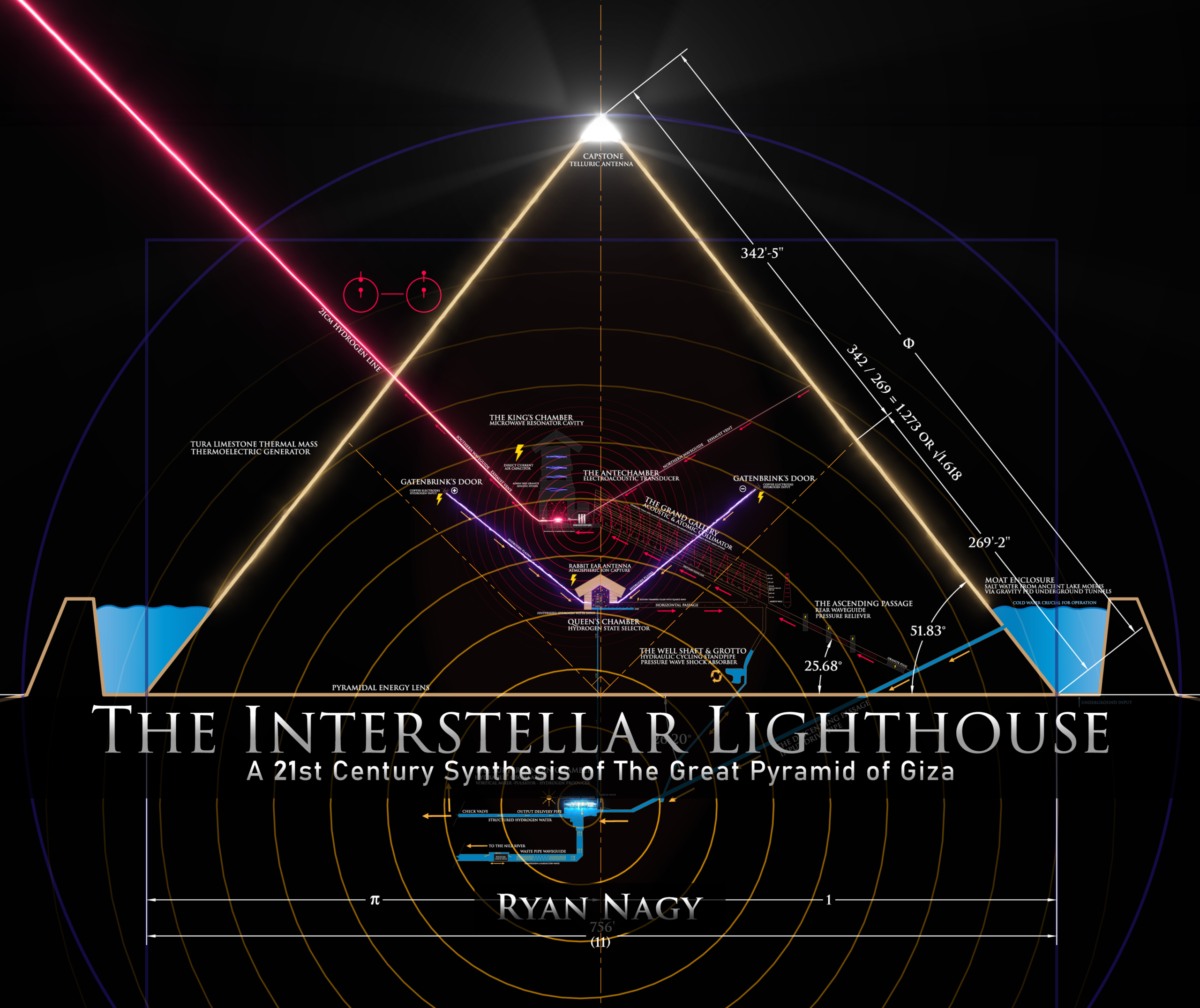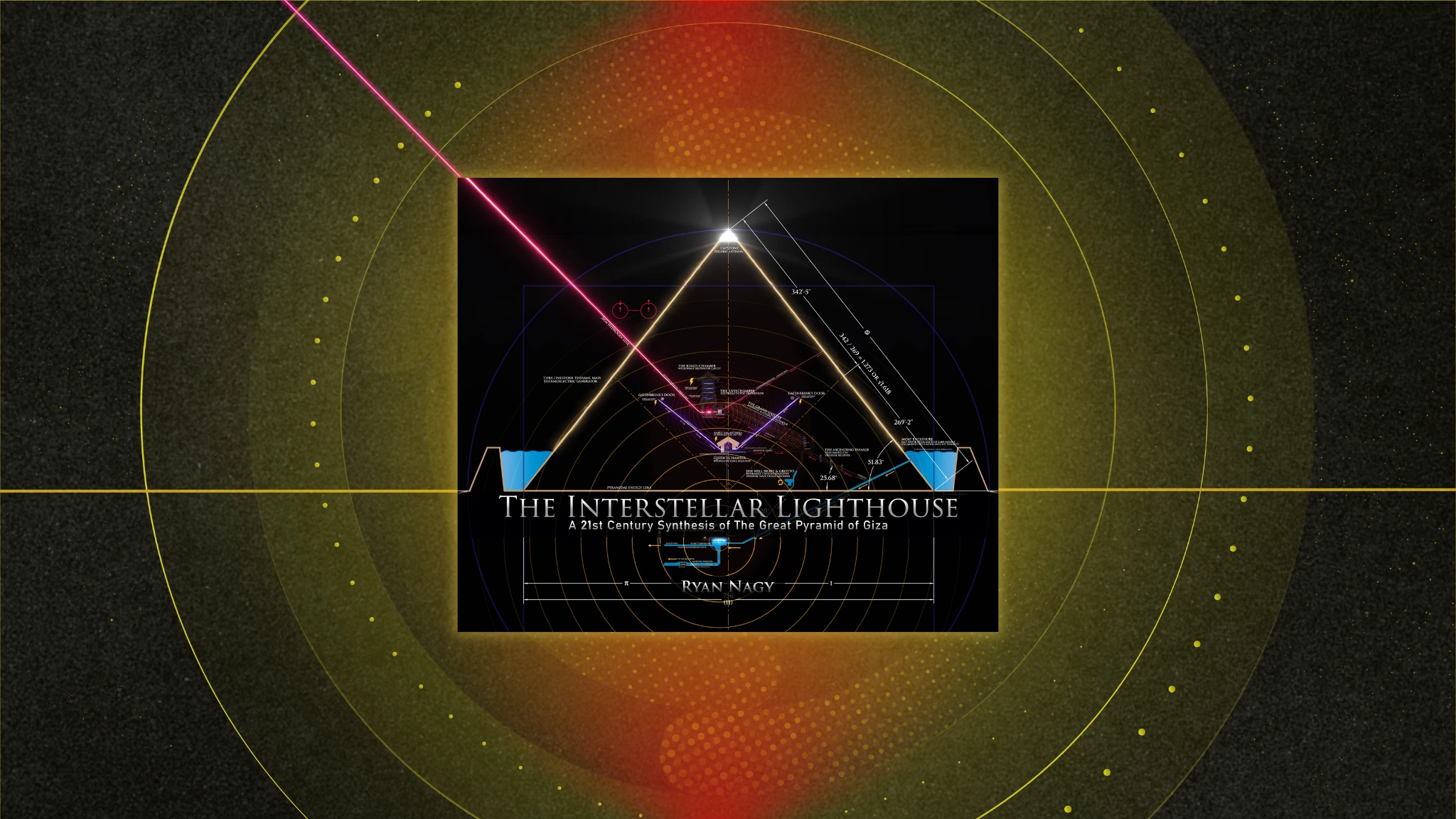The Interstellar Lighthouse: A 21st Century Synthesis of The Great Pyramid of Giza by Ryan Nagy
“The Great Pyramid wasn’t built simply as a tomb for a pharaoh but as a sophisticated engineering project that provided ancient Egypt with agricultural stability, electrical power, a timekeeping device and even the ability to communicate with the stars.”
The television show Ancient Aliens has been a source of entertainment for me over the last decade or so. Its mix of archeology, history, science and wild leaps of logic (“I’m not saying it was aliens … but it was aliens”) range from the intriguingly plausible to the utterly ridiculous. The fun of it is in the suspension of disbelief, never knowing where you are going to land in that spectrum by the end of each show. And it’s in that spirit that I began my read of The Interstellar Lighthouse: A 21st Century Synthesis of The Great Pyramid of Giza by Ryan Nagy.
From Ancient Aliens to Enlightening Insights
I was already familiar with many of the theories and concepts discussed in this thick, gorgeously illustrated volume but I quickly realized that television shows like Ancient Aliens, podcasts like The Why Files and even long-form documentaries don’t go into the kind of detail or make the kind of large-scale connections that Nagy lays out in such a methodical and comprehensive way in this book.
Perhaps it has to do with making the material appealing to a general audience. Perhaps it is the constraints of the medium or the media platform where such shows are distributed. Regardless, I came away from The Interstellar Lighthouse with a much better grasp of not only the theories and concepts I have encountered in these shows but also the evidence from which they arose. And some of that evidence, as it turns out, is more compelling than I previously thought.
Nagy’s project is an ambitious one — it is a survey of many schools of thought arising from the fringes of current scientific inquiry and the deep wells of wisdom inherent in spiritual traditions. It is also an attempt to “synthesize” these into a cohesive narrative that also leaves room for their variations and contradictions. The result is enormously impressive: an expansive view of cosmological cycles and their effects on Earth’s civilizations, using the example of the feats accomplished in the building of The Great Pyramid of Giza as a jumping-off point.
Bridging Science and Spirituality
The Interstellar Lighthouse is really several books in one. Roughly a third of the book is devoted to the evidence that The Great Pyramid wasn’t built simply as a tomb for a pharaoh but as a sophisticated engineering project that provided ancient Egypt with agricultural stability, electrical power, a timekeeping device and even the ability to communicate with the stars above. Nagy takes us through the entire system, both inside and outside the pyramid, explaining in detail the science and engineering concepts behind these claims. He also demonstrates how Egyptian spiritual beliefs intersected with technology in its operation. He draws upon and integrates many sources of research, providing deep insight into the topic.
Nagy then turns his attention to the influence of the constellation of Orion on not only the position and purpose of The Great Pyramid but also on various other ancient and indigenous cultures around the world. Here begins the true “synthesis” promised in the subtitle of the book, as he tackles theories of how the pyramids and other great megalithic sites around the world were built via acoustic levitation and dives into the theory that the ancient Egyptians were the custodians of technology developed by an earlier, advanced civilization we refer to in Western mythology as Atlantis. And yes, he also covers “ancient astronaut theories” popularized by Ancient Aliens.
From here, we explore the wide-ranging mythological narratives supporting the rise and fall of not just one earlier, advanced civilization but potentially many. In examining these cycles of destruction and creation, traditionally attributed to acts of divine intervention, like the Great Flood, Nagy goes beyond spiritual beliefs to look at the geological records left behind by such cataclysms. Beyond human history, Nagy takes us through prehistorical epochs of life on Earth and the possible influence of the Sun and other celestial forces on the climactic and terrestrial changes that mark each era.
Finally, Nagy turns his attention back to the cycles of human civilization and provides a historical overview of world events from the perspective of astrology and its basis in the Earth’s axial precession through the zodiac. It’s particularly interesting to see how the history you learned in school lays out in this structure and how this system of understanding provides new insights into patterns that underly our cultural and spiritual evolution through the ages.
Cosmic Cycles and Civilization
In case you feel that Nagy has strayed too far afield in his efforts to provide context for the significance and purpose of The Great Pyramid of Giza, think about this: all of his exploration of cycles, regardless of their cause or their scale, boils down to the idea that this megalithic structure stands today not only as a historical record but as a symbol of hope for the future. Just as it represents an amalgam of lost spiritual wisdom and technology, it also represents the pinnacle of human achievement.
If the cyclical nature of civilizations and life on Earth are indicative of our future, it is up to us to learn from the cycles that came before us, avoiding the mistakes of earlier civilizations and drawing upon their wisdom to attain new heights of societal evolution, technological prowess and, yes, spiritual enlightenment. And, Nagy argues, that begins where we are right now, in realigning our political and cultural systems to these goals.
About Ryan Nagy:
 Ryan Nagy, emerging from the pristine wilderness of Michigan’s Upper Peninsula, is an artist-geometer-draftsman-engineer-researcher who seamlessly melds the ancient and the modern. His rural immersion, free from the distractions of urban life, has sharpened his focus and deepened his connection to nature, fueling a unique blend of creativity and technical prowess. With over a decade of experience in CAD tools, Ryan channels the wisdom of the Pythagoreans and Ancient Egyptians, infusing it with cutting-edge technology.
Ryan Nagy, emerging from the pristine wilderness of Michigan’s Upper Peninsula, is an artist-geometer-draftsman-engineer-researcher who seamlessly melds the ancient and the modern. His rural immersion, free from the distractions of urban life, has sharpened his focus and deepened his connection to nature, fueling a unique blend of creativity and technical prowess. With over a decade of experience in CAD tools, Ryan channels the wisdom of the Pythagoreans and Ancient Egyptians, infusing it with cutting-edge technology.
Spearheading the InSpire Project, an audacious Trinitarian vision, he seeks to bridge the chasm of political extremities in today’s world. His philosophy of comprehensivism and synthesis weaves together diverse cultural threads, revealing the hidden commonalities that can unite humanity. Through the revival of the founding fathers’ ideological tenets and the divine custodianship of ancient pharaohs, Ryan envisions a future where ancient wisdom illuminates the path for modern innovation, crafting a world where harmony and diversity coexist in a symphony of human achievement.

Publish Date: 6/30/2024
Genre: Nonfiction
Author: Ryan Nagy
Page Count: 380 pages
ISBN: 9798991042604

